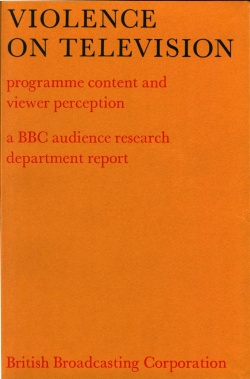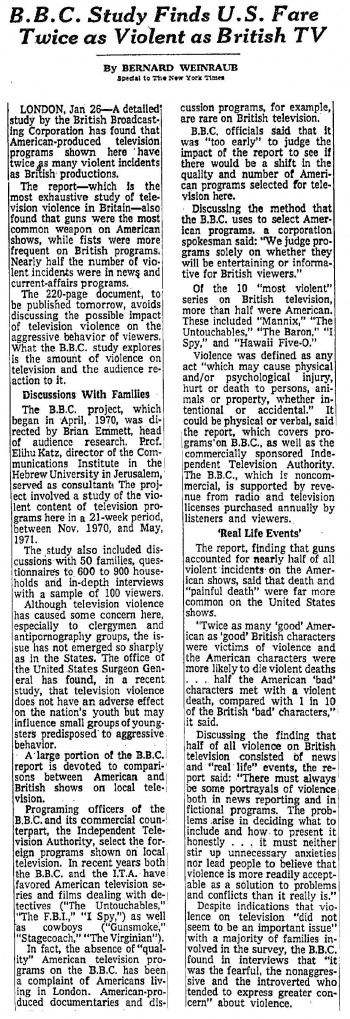B.B.C. Study Finds U.S. Fare Twice as Violent as British TV

- Publication: The New York Times
- Date: 1972-01-27
- Author: Bernard Weinraub
- Page: 75
- Language: English
Special to The New York Times
LONDON, Jan 26—A detailed study by the British Broadcasting Corporation has found that American-produced television programs shown here have twice as many violent incidents as British productions.
The report—which is the most exhaustive study of television violence in Britain—also found that guns were the most common weapon on American shows, while fists were more frequent on British programs. Nearly half the number of violent incidents were in news and current-affairs programs.
The 220-page document, to be published tomorrow, avoids discussing the possible impact of television violence on the aggressive behavior of viewers. What the B.B.C. study explores is the amount of violence on television and the audience reaction to it.
Discussions With Families
The B.B.C. project, which began in April, 1970, was directed by Brian Emmett, head of audience research. Prof. Elihu Katz, director of the Communications Institute in the Hebrew University in Jerusalem, served as consultant, The project involved a study of the violent content of television programs here in a 21-week period, between Nov. 1970, and May, 1971.
The study also included discussions with 50 families, questionnaires to 600 to 900 households and in-depth interviews with a sample of 100 viewers.
Although television violence has caused some concern here, especially to clergymen and antipornography groups, the issue has not emerged so sharply as in the States. The office of the United States Surgeon General has found, in a recent study, that television violence does not have an adverse effect on the nation's youth but may influence small groups of youngsters predisposed to aggressive behavior.
A large portion of the B.B.C. report is devoted to comparisons between American and, British shows on local television.
Programing officers of the B.B.C. and its commercial counterpart, the Independent Television Authority, select the foreign programs shown on local, television. In recent years both) the B.B.C. and the I.T.A. have favored American television series and films dealing with de-1 tectives ("The Untouchables," "The F.B.I.," "I Spy,") as well 'as cowboys ("Gunsmoke," "Stagecoach," "The Virginian").
In fact, the absence of "quality" American television programs on the B.B.C. has been a complaint of Americans living in London. American-produced documentaries and discussion programs, for example, are rare on British television.
B.B.C. officials said that it was "too early" to judge the impact of the report to see if there would be a shift in the quality and number of American programs selected for television here.
Discussing the method that the B.B.C. uses to select American programs. a corporation spokesman said: "We judge programs solely on whether they will be entertaining or informative for British viewers."
Of the 10 "most violent" series on British television, more than half were American. These included "Mannix," "The Untouchables," "The Baron," "I Spy," and "Hawaii Five-O."
Violence was defined as any act "which may cause physical and/or psychological injury, hurt or death to persons, animals or property, whether intentional or accidental." It could be physical or verbal, said the report, which covers programs on B.B.C., as well as the commercially sponsored Independent Television Authority. The B.B.C., which is noncommercial, is supported by revenue from radio and television licenses purchased annually by listeners and viewers.,
'Real Life Events'
The report, finding that guns accounted for nearly half of all violent incidents on the American shows, said that death and "painful death" were far more common on the United States shows.
"Twice as many 'good' American as 'good' British characters were victims of violence and the American characters were more likely to die violent deaths ... half the American 'bad' characters met with a violent death, compared with 1 in 10 of the British 'bad' characters," it said.
Discussing the finding that half of all violence on British television consisted of news and "real life" events, the report said: "There must always be some portrayals of violence both in news reporting and in fictional programs. The problems arise in deciding what to include and how to present it honestly . . . it must neither stir up unnecessary anxieties nor lead people to believe that violence is more readily acceptable as a solution to problems and conflicts than it really is."
Despite indications that violence on television "did not seem to be an important issue" with a majority of families involved in the survey, the B.B.C. found in interviews that "it was the fearful, the nonaggressive and the introverted who tended to express greater concern" about violence.
Disclaimer: These citations are created on-the-fly using primitive parsing techniques. You should double-check all citations. Send feedback to whovian@cuttingsarchive.org
- APA 6th ed.: Weinraub, Bernard (1972-01-27). B.B.C. Study Finds U.S. Fare Twice as Violent as British TV. The New York Times p. 75.
- MLA 7th ed.: Weinraub, Bernard. "B.B.C. Study Finds U.S. Fare Twice as Violent as British TV." The New York Times [add city] 1972-01-27, 75. Print.
- Chicago 15th ed.: Weinraub, Bernard. "B.B.C. Study Finds U.S. Fare Twice as Violent as British TV." The New York Times, edition, sec., 1972-01-27
- Turabian: Weinraub, Bernard. "B.B.C. Study Finds U.S. Fare Twice as Violent as British TV." The New York Times, 1972-01-27, section, 75 edition.
- Wikipedia (this article): <ref>{{cite news| title=B.B.C. Study Finds U.S. Fare Twice as Violent as British TV | url=http://cuttingsarchive.org/index.php/B.B.C._Study_Finds_U.S._Fare_Twice_as_Violent_as_British_TV | work=The New York Times | pages=75 | date=1972-01-27 | via=Doctor Who Cuttings Archive | accessdate=1 September 2024 }}</ref>
- Wikipedia (this page): <ref>{{cite web | title=B.B.C. Study Finds U.S. Fare Twice as Violent as British TV | url=http://cuttingsarchive.org/index.php/B.B.C._Study_Finds_U.S._Fare_Twice_as_Violent_as_British_TV | work=Doctor Who Cuttings Archive | accessdate=1 September 2024}}</ref>
